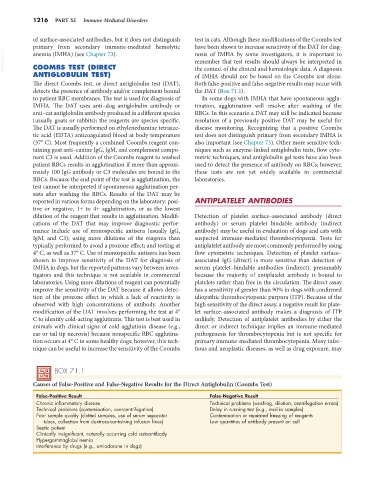Page 1244 - Small Animal Internal Medicine, 6th Edition
P. 1244
1216 PART XI Immune-Mediated Disorders
of surface-associated antibodies, but it does not distinguish test in cats. Although these modifications of the Coombs test
primary from secondary immune-mediated hemolytic have been shown to increase sensitivity of the DAT for diag-
VetBooks.ir anemia (IMHA) (see Chapter 73). nosis of IMHA by some investigators, it is important to
remember that test results should always be interpreted in
COOMBS TEST (DIRECT
ANTIGLOBULIN TEST) the context of the clinical and hematologic data. A diagnosis
of IMHA should not be based on the Coombs test alone.
The direct Coombs test, or direct antiglobulin test (DAT), Both false-positive and false-negative results may occur with
detects the presence of antibody and/or complement bound the DAT (Box 71.1).
to patient RBC membranes. The test is used for diagnosis of In some dogs with IMHA that have spontaneous agglu-
IMHA. The DAT uses anti–dog antiglobulin antibody or tination, agglutination will resolve after washing of the
anti–cat antiglobulin antibody produced in a different species RBCs. In this scenario a DAT may still be indicated because
(usually goats or rabbits); the reagents are species specific. resolution of a previously positive DAT may be useful for
The DAT is usually performed on ethylenediamine tetraace- disease monitoring. Recognizing that a positive Coombs
tic acid (EDTA) anticoagulated blood at body temperature test does not distinguish primary from secondary IMHA is
(37° C). Most frequently a combined Coombs reagent con- also important (see Chapter 73). Other more sensitive tech-
taining goat anti–canine IgG, IgM, and complement compo- niques such as enzyme-linked antiglobulin tests, flow cyto-
nent C3 is used. Addition of the Coombs reagent to washed metric techniques, and antiglobulin gel tests have also been
patient RBCs results in agglutination if more than approxi- used to detect the presence of antibody on RBCs; however,
mately 100 IgG antibody or C3 molecules are bound to the these tests are not yet widely available in commercial
RBCs. Because the end point of the test is agglutination, the laboratories.
test cannot be interpreted if spontaneous agglutination per-
sists after washing the RBCs. Results of the DAT may be
reported in various forms depending on the laboratory: posi- ANTIPLATELET ANTIBODIES
tive or negative, 1+ to 4+ agglutination, or as the lowest
dilution of the reagent that results in agglutination. Modifi- Detection of platelet surface–associated antibody (direct
cations of the DAT that may improve diagnostic perfor- antibody) or serum platelet bindable antibody (indirect
mance include use of monospecific antisera (usually IgG, antibody) may be useful in evaluation of dogs and cats with
IgM, and C3); using more dilutions of the reagents than suspected immune-mediated thrombocytopenia. Tests for
typically performed to avoid a prozone effect; and testing at antiplatelet antibody are most commonly performed by using
4° C, as well as 37° C. Use of monospecific antisera has been flow cytometric techniques. Detection of platelet surface–
shown to improve sensitivity of the DAT for diagnosis of associated IgG (direct) is more sensitive than detection of
IMHA in dogs, but the reported patterns vary between inves- serum platelet–bindable antibodies (indirect), presumably
tigators and this technique is not available in commercial because the majority of antiplatelet antibody is bound to
laboratories. Using more dilutions of reagent can potentially platelets rather than free in the circulation. The direct assay
improve the sensitivity of the DAT because it allows detec- has a sensitivity of greater than 90% in dogs with confirmed
tion of the prozone effect in which a lack of reactivity is idiopathic thrombocytopenic purpura (ITP). Because of the
observed with high concentrations of antibody. Another high sensitivity of the direct assay, a negative result for plate-
modification of the DAT involves performing the test at 4° let surface–associated antibody makes a diagnosis of ITP
C to identify cold-acting agglutinins. This test is best used in unlikely. Detection of antiplatelet antibodies by either the
animals with clinical signs of cold agglutinin disease (e.g., direct or indirect technique implies an immune-mediated
ear or tail tip necrosis) because nonspecific RBC agglutina- pathogenesis for thrombocytopenia but is not specific for
tion occurs at 4° C in some healthy dogs; however, this tech- primary immune-mediated thrombocytopenia. Many infec-
nique can be useful to increase the sensitivity of the Coombs tious and neoplastic diseases, as well as drug exposure, may
BOX 71.1
Causes of False-Positive and False-Negative Results for the Direct Antiglobulin (Coombs Test)
False-Positive Result False-Negative Result
Chronic inflammatory disease Technical problems (washing, dilution, centrifugation errors)
Technical problems (contamination, overcentrifugation) Delay in running test (e.g., mail-in samples)
Poor sample quality (clotted samples, use of serum separator Contamination or repeated freezing of reagents
tubes, collection from dextrose-containing infusion lines) Low quantities of antibody present on cell
Septic patient
Clinically insignificant, naturally occurring cold autoantibody
Hypergammaglobulinemia
Interference by drugs (e.g., amiodarone in dogs)

